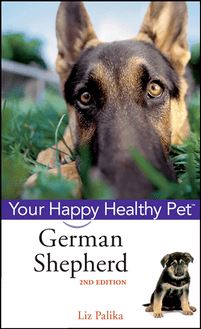The Lhasa Apso , livre ebook
110
pages
English
Ebooks
2008
Vous pourrez modifier la taille du texte de cet ouvrage
Obtenez un accès à la bibliothèque pour le consulter en ligne En savoir plus
Découvre YouScribe en t'inscrivant gratuitement
Découvre YouScribe en t'inscrivant gratuitement
110
pages
English
Ebooks
2008
Vous pourrez modifier la taille du texte de cet ouvrage
Obtenez un accès à la bibliothèque pour le consulter en ligne En savoir plus
Publié par
Date de parution
21 avril 2008
Nombre de lectures
0
EAN13
9780470336779
Langue
English
Poids de l'ouvrage
1 Mo
All books contain information on:
- feeding
- grooming
- housing
- health care
- what to expect from the pet
- basic training
Happy, Healthy Pet guides are rich with professional quality color photos and are designed to be enjoyable and easy to learn from.
The Lhasa Apso dog is a steadfast favorite AKC registered breed. More and more people are finding out that this hardy little dog makes a wonderful family pet. Carolyn Herbel, from Putnam, Oklahoma, shows and breeds Lhasa Apsos.
PART ONE: Welcome to the World of the Lhasa Apso.
1. What Is a Lhasa Apso?
2. The Lhasa Apso's Ancestry.
3. The World According to the Lhasa Apso.
PART TWO: Living with a Lhasa Apso.
4. Bringing Your Lhasa Apso Home.
5. Feeding Your Lhasa Apso.
6. Grooming Your Lhasa Apso.
7. Keeping Your Lhasa Apso Healthy.
PART THREE: Enjoying Your Dog.
8. Basic Training (Ian Dunbar, Ph.D., MRCVS).
9. Getting Active with Your Dog (Bardi McLennan).
10. Your Dog and Your Family (Bardi McLennan).
11. Your Dog and Your Community (Bardi McLennan).
PART FOUR: Beyond the Basics.
12. Recommended Reading.
13. Resources.
Publié par
Date de parution
21 avril 2008
Nombre de lectures
0
EAN13
9780470336779
Langue
English
Poids de l'ouvrage
1 Mo
The
Lhasa Apso
Howell Book House
Hungry Minds, Inc.
909 Third Avenue
New York, NY 10022
www.hungryminds.com
Copyright 1998, 2001 Howell Book House, a wholly owned subsidiary of Hungry Minds, Inc.
All rights reserved. No part of this book may be reproduced or transmitted in any form or by any means, electronic or mechanical, including photocopying, recording, or by an information storage and retrieval system, without permission in writing from the Publisher.
Howell Book House is a registered trademark of Hungry Minds, Inc.
For general information on Hungry Minds books in the U.S., please call our Consumer Customer Service department at 800-762-2974. In Canada, please call (800) 667-1115. For reseller information, including discounts and premium sales, please call our Reseller Customer Service department at 800-434-3422.
Library of Congress Cataloging-in-Publication Data
Herbel, Carolyn.
The lhasa apso: an owner s guide to happy, healthy pet/by Carolyn Herbel.
p.cm.
Includes bibliographical references
ISBN 0-87605-228-6
1. Lhasa apso. I. Title. II. Series
SF429.L5H46 1998, 2001 98-17604
636.72-dc21 CIP
Manufactured in the United States of America
10 9 8 7 6 5 4
Series Director: Kira Sexton
Book Design: Michele Laseau
Cover Design: Michael Freeland
Photography Editor: Richard Fox
Illustration: Jeff Yesh
Photography:
Front and back cover photos supplied by Jennie Harrison/Close Encounters of the Furry Kind.
Joan Balzarini: 96
Mary Bloom: 96, 136, 145
Paulette Braun: Title page, 2-3, 43, 70, 96
Buckinghambill American Cocker Spaniels: 148
JoAnn Clulow: 9, 11, 52, 53
Sian Cox: 134
Brona David: 27
Dr. Ian Dunbar: 98, 101, 103, 111, 11 116-117. 122, 123, 127
Carolyn Herbel: 5, 17, 18, 20, 21, 39, 41, 47
Howell Book House (archival photos): 16
Dan Lyons: 96
Cathy Merrithew: 129
Liz Palika: 133
Susan Rezy: 96-97
Bob Schwartz: 13, 15, 19, 24, 25, 33. 40, 51, 68
Sara Sechrest: 75, 93
Judith Strom: 96, 107, 110, 128, 130, 135, 137, 139, 140, 144, 149,150
Toni Tucker: 45, 69
Faith Uridel: 7, 8, 23, 30-31, 32, 37, 44, 56, 57, 58, 59, 60, 61, 64
Page creation by: Hungry Minds Indianapolis Production Department
Contents
part one
Welcome to the World of the Lhasa Apso
1 What Is a Lhasa Apso?
2 The Lhasa Apso s Ancestry
3 The World According to the Lhasa Apso
part two
Living with a Lhasa Apso
4 Bringing Your Lhasa Apso Home
5 Feeding Your Lhasa Apso
6 Grooming Your Lhasa Apso
7 Keeping Your Lhasa Apso Healthy
part three
Enjoying Your Dog
8 Basic Training
by Ian Dunbar, Ph.D., MRCVS
9 Getting Active with Your Dog
by Bardi McLennan
10 Your Dog and Your Family
by Bardi McLennan
11 Your Dog and Your Community
by Bardi McLennan
part four
Beyond the Basics
12 Recommended Reading
13 Resources
chapter 1
What Is a Lhasa Apso?
The Lhasa Apso is a small, spirited canine with long hair covering him from head to tail. The Lhasa Apso originates from the remote country of Tibet where he was a companion and a small indoor guard dog. Tibet was a relatively primitive country, and survival was the primary concern of both the people and the animals that inhabited it. Out of this environment came the Lhasa Apso, who developed into a naturally hardy watchdog with an especially discerning temperament.
The Breed Standard
The American Lhasa Apso standard describes the behavior and appearance of the Lhasa Apso and was first approved by the American Kennel Club in 1935. A substantial part of the American standard was derived from the original English standard (which was adopted in 1934 when the English Tibetan Breeds Association defined and divided the Tibetan breeds). At about this time the English Kennel Club also declared that Lhasa Terriers (later renamed Lhasa Apsos) and Shih Tzus were not the same breed, and therefore would be registered separately.
The American Lhasa Apso standard remained unchanged for forty-three years and was only slightly revised in 1978 when the gold coat color preference was removed, making all coat colors equally acceptable; the preference for the slightly undershot bite was made equal to the preference for the level mouth; and the preference for a 1-inch muzzle length was removed.
The American standard is divided into a list of twelve categories, which is very brief when compared to the other breed standards. Some people speculate that the standard is actually a list of traits that describe the little dog from Tibet and also those traits that differentiate the Lhasa Apso from the Shih Tzu.
C HARACTER
Gay and assertive, but chary of strangers.
The authors of the standard must have felt that the character of the Lhasa Apso was distinctly important because the first statement describes the Lhasa Apso as a dog that has a happy, confident temperament and chooses new friends carefully. The word assertive can equate to stubbornness in some Lhasa Apsos, while in most it simply means an assured character. As a result of the Lhasa Apsos longtime indoor sentry work in Tibet, they are extraordinarily alert and quick to give warning of anything unusual. The Lhasa Apso may be standoffish with strangers; however, many have developed a more friendly attitude because they share common ancestors with the amiable Shih Tzu. The Lhasa Apso is very sensitive to the moods of his owner and responds accordingly. He likes to be with his human family, but does not act as an obedient servant because he considers himself an equal member of the family. A typical Lhasa Apso does not live for you-he lives with you.
The Lhasa Apso is a happy, confident dog who is sensitive to his owner s moods.
A good way to evaluate the possible future temperament of a Lhasa Apso puppy is to interact with his parents. The parents should not be high-strung or aggressive. Most Lhasa Apso puppies are friendly to strangers until they are about 6 months old, when they usually become more discerning about making friends. If puppies act fearful or aggressive at a much younger age, it may mean that they will be even more reluctant to accept strangers when they mature.
Lhasas and Children
Lhasa Apsos that are raised from puppyhood with well-behaved children love them. Not all Lhasa Apsos, however, readily accept the quick movements, hair pulling and unsure footsteps of toddlers, unless they have been introduced to these little people first.
S IZE
Variable, but about ten inches or eleven inches at shoulder for dogs; bitches slightly smaller.
The size standard is only defined by height. The word variable means that the height of the Lhasa Apso varies between 10 and 11 inches, and the word about means that there is an allowance above and below the 10 or 11 inches designated in the standard. Bitches slightly smaller means that females should not only be smaller, but should also have feminine traits. Another category in the standard that pertains to size is the proportion and condition of body shape.
B ODY S HAPE
The length from point of shoulders to point of buttocks longer than height at withers, well ribbed up, strong loin, well developed quarters and thighs.
The description of height, proportion and body shape in the standard was most likely determined by observing the structure of Lhasa Apsos in Tibet as well as those that were imported to England and the United States. The description of length means that when viewed from the side, the Lhasa Apso should look distinctly rectangular, not square shaped. Though weight is not mentioned in the standard, well-conditioned Lhasa Apsos with strong loins, quarters and thighs should weigh 16 to 18 pounds for males and 12 to 14 pounds for females.
The shape of the Lhasa Apso should be rectangular rather than square.
Certainly larger and smaller dogs existed in Tibet, yet appraisal of the small Tibetan watchdog known as the Lhasa Apso determined the size description in the standard. Deviating more than inch from this desired height starts to change the efficient, hardy body structure and handy indoor size developed due to the Tibetan environment. The choice of a pet should not be made entirely on size, but it is important to see the parents in order to approximate the size your puppy may be as an adult. If one of the deciding factors for choosing a Lhasa Apso is that they are small dogs, it would be disappointing to have your puppy grow much larger than you expected.
C OLORS
All colors equally acceptable with or without dark tips to ears and beard.
The original English and American standards listed colors in order of preference: (T)his being the true Tibetan Lion-dog, golden or lionlike colors are preferred. The preference for golden or lionlike colors developed because this was the color that the Western travelers saw and liked the most during visits to Tibet- especially in the capital city of Lhasa from which most of the dogs came from. Parti-color was probably among the least preferred colors because this color pattern was more often associated with the Shih Tzu. In 1978, the color section of the standard was changed to make all colors of equal value.
The standard colors that appear on the AKC s individual registration form are black; black and tan; cream; golden; grizzle; red; red gold and white. The second choice in describing a color is the marking/pattern portion of the form, which consists of black mask with tips; black tips; brindle; parti-color; sable and white markings.
The definitions of the standard colors and markings/ patterns are as follows:
Black and tan is one of the AKC s standard Lhasa Apso colors.
Black -solid black
Black and tan -typical black and tan markings, i.e., black body color with tan spots above eyes, on eyes, cheeks, muzzle, chest, legs and vent
Cream -almost white to darker shades of cream
Golden -pale gold to wheaten
Grizzle -bluish-gray or iron-gray color due to a mixture of black and white hairs
Red -solid red with shades from Vis














